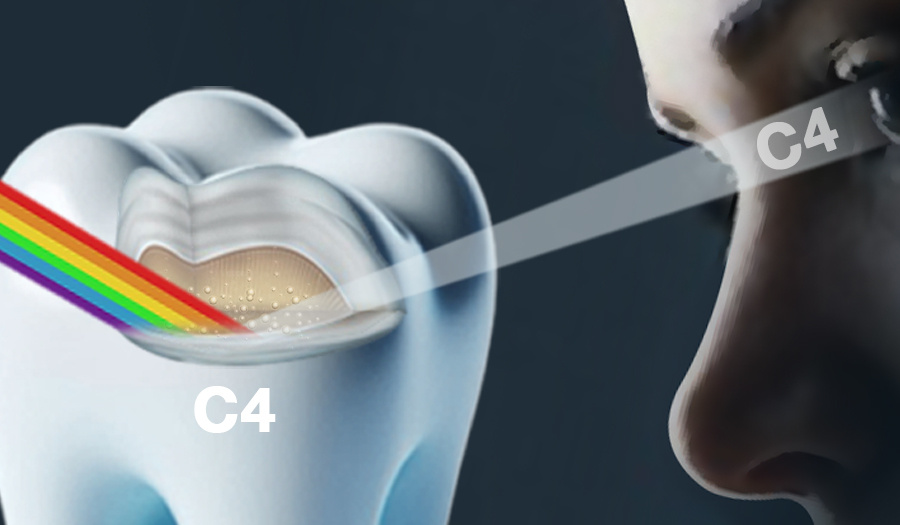When Your Profits and Quality of Your Work Evaporate Into Thin Air
In the Beginning Adhesive dental restorations have had an incredible impact on the clinical dental procedures that are performed today. Before the...
2 min read
VOCO America Inc : 08/243/2024

Achieving a shade-matched restoration has always been a blend of art and science in restorative dentistry. Between shade guides, layering techniques, and managing substrates, even experienced clinicians must juggle many variables. The growing class of single-shade or universal shade restoratives aims to simplify that process. But what does recent research actually tell us about their performance?
Single-shade restoratives use advanced optical strategies such as structural color, high filler loading, and precise control of translucency and refractive index to allow the restoration to “borrow” appearance from the surrounding enamel and dentin¹. For example, materials like Omnichroma use supra-nano spherical fillers (~260 nm) that generate color through filler structure rather than pigments². Admira Fusion x-tra goes further in its chemistry: its ORMOCER® matrix reduces shrinkage, increases wear resistance, and helps retain surface gloss over time³.
A systematic review of randomized trials (> 250 restorations) found that over 12 months, single-shade and multi-shade composites had comparable color match and stability when evaluated with standard clinical criteria⁴.
In a two-year split-mouth trial involving children, Admira Fusion x-tra outperformed a conventional nano-hybrid (Grandio from VOCO) in preserving surface luster and resisting superficial changes, though both performed acceptably⁵.
Studies of Class II and non-carious cervical restorations show that when restoration margins are well managed, the marginal integrity and secondary caries incidence for Admira Fusion x-tra are similar to multi-shade composites over 12–18 months⁶⁷.
On the downside, longer follow-ups show that staining and color deviations do increase over time in all materials, including Admira Fusion x-tra, though the rate is slower compared with some conventional composites⁵.
If you often restore posterior teeth, manage high patient volume, or need simpler inventory, single-shade restoratives (especially those with ORMOCER® or other advanced chemistries) can save time and effort while delivering very acceptable esthetics³⁴. For anterior work, cases with discolored underlying structure, or when patients have high esthetic expectations, multi-shade layering may still be the gold standard⁶.
Why Admira Fusion x-tra Is Especially Well-SupportedAdmira Fusion x-tra combines several of the “best-practice” features from recent research: a high filler load, bulk-fill capability, low polymerization shrinkage, good color match in a wide range of conditions, strong performance in maintaining gloss and marginal adaptation, and clinical trials supporting its use³⁵⁶.
If your practice is looking to streamline restorative protocols without compromising esthetic or long-term performance, Admira Fusion x-tra is among the most evidence-backed choices for universal shade restoratives today.
Paravina RD, Westland S. Color adjustment potential of dental materials: concepts and clinical significance. J Esthet Restor Dent. 2021;33(1):4–11.
Omnichroma product science: Tokuyama Dental. Structural color technology. Available at: Tokuyama Dental
The Dental Advisor. Clinical evaluation of Admira Fusion x-tra. Available at: Dental Advisor
Altin N, et al. Color stability and clinical performance of single-shade vs multi-shade resin composites: systematic review and meta-analysis. Polymers (Basel). 2024;16(15):2172.
Çehreli SB, et al. Two-year clinical performance of an ORMOCER-based single-shade bulk-fill composite versus a nano-hybrid composite in pediatric patients. Clin Oral Investig. 2024;28(5):3025-3036.
Yasa E, et al. Randomized clinical trial of a single-shade ORMOCER bulk-fill composite in non-carious cervical lesions: 18-month results. J Dent. 2024;146:105126.
Abdel-Aziz AM, et al. Clinical performance of a Bis-GMA-free single-shade bulk-fill composite compared to a methacrylate-based bulk-fill composite in Class II restorations: 12-month RCT. BMC Oral Health. 2023;23:759.

In the Beginning Adhesive dental restorations have had an incredible impact on the clinical dental procedures that are performed today. Before the...

The recent announcement of the world’s first fully automated dental procedure, performed by a U.S.-based AI company, has certainly captured the...

VOCO is thrilled to introduce a podcast that's a must-listen for every dental hygienist seeking to enhance their professional knowledge while being...